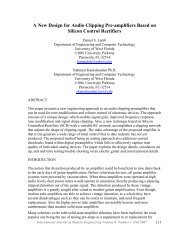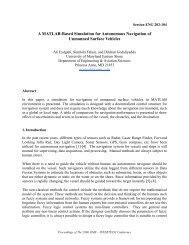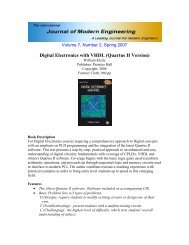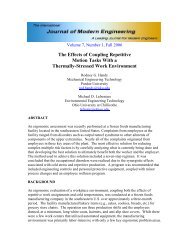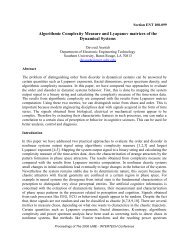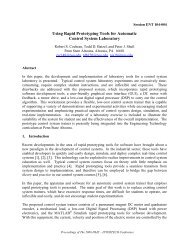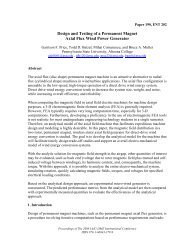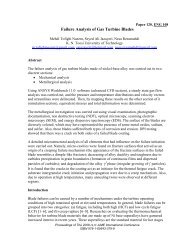WIP: A Study on the Development of Endodontic Micro Robot - IJME
WIP: A Study on the Development of Endodontic Micro Robot - IJME
WIP: A Study on the Development of Endodontic Micro Robot - IJME
Create successful ePaper yourself
Turn your PDF publications into a flip-book with our unique Google optimized e-Paper software.
• Vacuum attachments capable <strong>of</strong> sucking <strong>the</strong> debris or loose tissue from <strong>the</strong> root<br />
canal and/or pressurized soluti<strong>on</strong> jets to flush <strong>the</strong> chips away.<br />
A preliminary quantitative study established <strong>the</strong> design requirements. In order to provide<br />
accurate positi<strong>on</strong>ing <strong>of</strong> <strong>the</strong> tool, with correct angular orientati<strong>on</strong>, an ideal basic machine<br />
must have five degrees <strong>of</strong> freedom to c<strong>on</strong>trol <strong>the</strong> following axes:<br />
• X-axis, al<strong>on</strong>g <strong>the</strong> teeth row, with travel range <strong>of</strong> 5 mm;<br />
• Y-axis, across <strong>the</strong> teeth row, with travel range <strong>of</strong> 4 mm;<br />
• Z-axis, <strong>the</strong> tool advancement directi<strong>on</strong>, perpendicular to <strong>the</strong> tooth occlusal<br />
surface, with a travel range <strong>of</strong> 15 mm minimum. When using a l<strong>on</strong>ger tool, <strong>the</strong><br />
endod<strong>on</strong>tic tool should be able to reach 28 mm from <strong>the</strong> tooth crown, covering <strong>the</strong><br />
required range <strong>of</strong> treatment;<br />
• The angular adjustment <strong>of</strong> <strong>the</strong> tool entrance angle <strong>of</strong> ± 12° in <strong>the</strong> X-Z plane;<br />
• The angular adjustment <strong>of</strong> <strong>the</strong> tool entrance angle <strong>of</strong> ± 12º in <strong>the</strong> Y-Z plane.<br />
In additi<strong>on</strong>, <strong>the</strong> design must meet <strong>the</strong> following requirements:<br />
• The size <strong>of</strong> <strong>the</strong> machine must be compact enough to fit into <strong>the</strong> patient’s mouth<br />
and sit <strong>on</strong> <strong>the</strong> teeth between his/her two jaws. The dimensi<strong>on</strong> should be within 20<br />
mm x 20 mm x 28 mm;<br />
• The spindle must have <strong>the</strong> rotati<strong>on</strong>al power to drive <strong>the</strong> tool at speeds and torque<br />
used in endod<strong>on</strong>tic treatment tools;<br />
• The machine should be able to provide a thrust force not less than 500g (4.9<br />
Newt<strong>on</strong>s) for tool penetrati<strong>on</strong> into <strong>the</strong> crown and dentin.<br />
ENDODONTIC MICRO ROBOT MECHANICAL DESIGN<br />
There are many different potential machine c<strong>on</strong>figurati<strong>on</strong>s. A weighted decisi<strong>on</strong> matrix<br />
was completed to determine which design fits most closely to <strong>the</strong> design criteria and<br />
satisfies <strong>the</strong> engineering characteristics above. Figure 2 shows a winning mechanical<br />
design <strong>of</strong> a multi-purpose micro machine for root canal treatment. As indicated in <strong>the</strong><br />
figure, this machine has five axes <strong>of</strong> moti<strong>on</strong>: linear moti<strong>on</strong> in <strong>the</strong> X, Y, Z directi<strong>on</strong>s, and<br />
rotati<strong>on</strong>al moti<strong>on</strong> in θ x ,θ y directi<strong>on</strong>s. The tilt angles θ x ,θ y are c<strong>on</strong>trolled by additi<strong>on</strong>al<br />
linear actuators X’ and Y’. There is ano<strong>the</strong>r rotati<strong>on</strong>al moti<strong>on</strong> provided for <strong>the</strong> spindle ω z .<br />
The machine has a saddle-shaped base. It will ride <strong>on</strong> a pair <strong>of</strong> reference brackets and <strong>the</strong><br />
teeth. Before taking X-rays and mounting this machine, <strong>the</strong> brackets, in assorted sizes to<br />
fit <strong>the</strong> patients' teeth must be pre-clamped firmly <strong>on</strong> <strong>the</strong> tooth to be treated. Neighboring<br />
teeth may be used as support.<br />
The bracket pair provides three radiopaque reference points for <strong>the</strong> machine registrati<strong>on</strong>,<br />
thus establishing a coordinati<strong>on</strong> system. Once <strong>the</strong> machine is seated <strong>on</strong> <strong>the</strong> reference<br />
bracket, <strong>the</strong> machine base will have no moti<strong>on</strong> relative to <strong>the</strong> patient’s teeth, regardless <strong>of</strong><br />
<strong>the</strong> patient's head or jaw movements. The machine is designed to be compact and rigid so<br />
that <strong>the</strong> patient can bite <strong>on</strong> it. See Figure 3. There is no need for <strong>the</strong> patient to actively<br />
Internati<strong>on</strong>al Journal <strong>of</strong> Modern Engineering Volume 8, Number 1 Fall 2007 30



